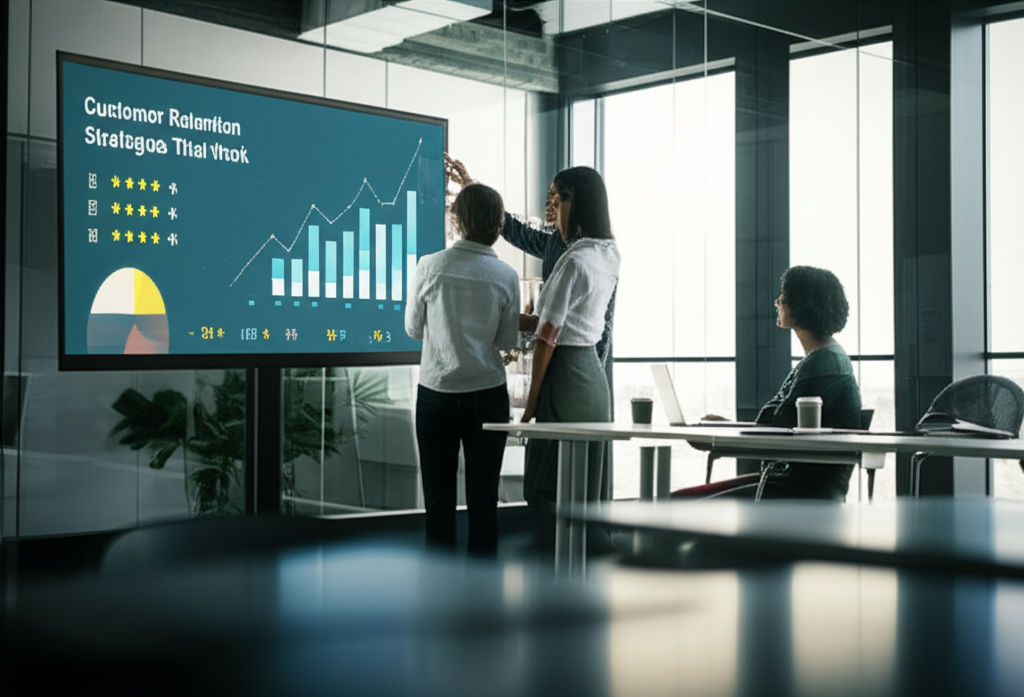Effective SEO Strategies to Increase Your Website Traffic
Emily Willis

Photo: Effective SEO Strategies to Increase Your Website Traffic
Search Engine Optimization (SEO) is the art and science of improving your website's visibility on search engine results pages (SERPs). By implementing effective SEO strategies, you can attract more organic traffic, enhance your brand's credibility, and ultimately boost your business's bottom line.
Understanding the Basics of SEO
Before diving into specific strategies, it's essential to grasp the fundamental concepts of SEO.
- Search Engines: Understand how search engines like Google, Bing, and Yahoo work. They crawl websites, index content, and rank pages based on relevance and quality.
- Keywords: Identify relevant keywords and phrases that your target audience is searching for. These keywords should be incorporated naturally into your website's content.
- On-Page SEO: Optimize your website's content, structure, and HTML elements to improve search engine visibility.
- Off-Page SEO: Build high-quality backlinks from other websites to enhance your website's authority and credibility.
- Technical SEO: Ensure your website is technically sound and optimized for search engines, including factors like website speed, mobile-friendliness, and site structure.
Keyword Research: Finding the Right Words
Keyword research is the cornerstone of any successful SEO strategy. By identifying the keywords and phrases your target audience is using, you can tailor your content to their search intent.
- Identify Relevant Keywords: Use keyword research tools to find keywords related to your business and industry.
- Analyze Search Intent: Understand the purpose behind search queries to create content that truly addresses user needs.
- Long-Tail Keywords: Focus on long-tail keywords (more specific phrases) to target niche audiences and improve search engine rankings.
- Keyword Mapping: Match keywords to relevant pages on your website to optimize content and structure.
Creating High-Quality Content
Content is king when it comes to SEO. High-quality, informative, and engaging content attracts both search engines and users.
- User-Centric Content: Create content that addresses your target audience's needs, questions, and pain points.
- Keyword Optimization: Incorporate relevant keywords naturally into your content without compromising readability.
- Content Format Variety: Use a mix of blog posts, articles, videos, infographics, and other formats to cater to different audience preferences.
- Content Length: While there's no definitive ideal length, comprehensive content often ranks better.
- Fresh Content: Regularly update your website with fresh content to keep users engaged and search engines crawling.
On-Page SEO: Optimizing Your Website
On-page SEO involves optimizing elements on your website to improve search engine visibility.
- Title Tags and Meta Descriptions: Create compelling title tags and meta descriptions that accurately reflect your page's content and include relevant keywords.
- Header Tags (H1, H2, H3, etc.): Use header tags to structure your content and highlight important keywords.
- Image Optimization: Optimize image file names, alt text, and captions with relevant keywords.
- URL Structure: Create clean and descriptive URLs that include relevant keywords.
- Internal Linking: Connect related pages within your website to improve navigation and distribute link equity.
Off-Page SEO: Building Backlinks
Off-page SEO focuses on building high-quality backlinks from other websites to your own. Backlinks are like votes of confidence from other websites, signaling to search engines that your content is valuable.
- Link Building Strategies: Implement strategies like guest posting, content promotion, and outreach to earn backlinks.
- Link Quality: Prioritize backlinks from authoritative and relevant websites.
- Link Diversity: Build backlinks from various sources to demonstrate your website's credibility.
Technical SEO: Ensuring Website Health
Technical SEO involves optimizing your website's technical aspects to improve search engine crawlability and indexability.
- Website Speed: Optimize website loading speed for better user experience and search engine rankings.
- Mobile-Friendliness: Ensure your website is responsive and optimized for mobile devices.
- Website Structure: Create a clear and logical website structure with easy navigation.
- XML Sitemap: Create an XML sitemap to help search engines discover and index your website's pages.
- HTTPS: Use HTTPS to secure your website and enhance user trust.
Measuring and Analyzing Your SEO Performance
Tracking and analyzing your SEO performance is crucial for understanding what's working and what needs improvement.
- Google Analytics: Use Google Analytics to track website traffic, user behavior, and goal conversions.
- Search Console: Monitor search engine performance, keyword rankings, and crawl errors.
- Keyword Ranking Tracking: Track your website's rankings for target keywords over time.
- Conversion Tracking: Measure the effectiveness of your SEO efforts in driving desired actions, such as leads or sales.
- A/B Testing: Experiment with different SEO strategies to identify what works best for your website.
Remember, SEO is an ongoing process. It requires patience, persistence, and a willingness to adapt to algorithm changes. By implementing these strategies and continuously monitoring your performance, you can improve your website's visibility and attract more organic traffic.
fundamental concepts of SEO and outlined essential strategies for optimizing your website and content to attract more organic traffic. Now, let's delve into specific tactics and techniques that can further enhance your SEO efforts.
1. Optimize Your Website for Local Search
If your business has a physical location or caters to a specific geographic area, local SEO is crucial for attracting nearby customers.
- Google My Business (GMB): Create and optimize your GMB listing to appear in local search results and on Google Maps.
- Local Keywords: Include relevant local keywords in your website content, title tags, and meta descriptions.
- Local Citations: Build backlinks from local directories, business listings, and community websites.
- Customer Reviews: Encourage positive reviews from customers on GMB and other platforms.
- Location Pages: Create dedicated pages for each location if you have multiple branches.
2. Utilize Structured Data Markup
Structured data markup is a code snippet that provides search engines with additional information about your website's content, enhancing its understanding and presentation in search results.
- Schema Markup: Use Schema markup to define various types of content, such as articles, products, events, and local businesses.
- Rich Snippets: Rich snippets are enhanced search results that display additional information, such as star ratings, event details, or product pricing.
- Breadcrumbs: Implement breadcrumbs to improve website navigation and help search engines understand your site structure.
- FAQ Schema: Use FAQ schema to display frequently asked questions and answers directly in search results.
3. Build Relationships with Influencers
Influencer marketing involves collaborating with influential individuals in your industry to promote your products or services to their followers.
- Identify Relevant Influencers: Find influencers who align with your brand values, target audience, and industry expertise.
- Develop Authentic Partnerships: Establish genuine relationships with influencers, ensuring they believe in your product or service.
- Create Collaborative Campaigns: Work with influencers to develop creative and engaging campaigns that resonate with their audience.
- Track Campaign Performance: Monitor influencer engagement, reach, and conversions to measure campaign effectiveness.
- Nurture Influencer Relationships: Maintain positive relationships with your influencers for ongoing collaborations.
4. Leverage Social Media for SEO
Social media platforms offer a powerful channel for promoting your website content, building brand awareness, and driving organic traffic.
- Social Media Optimization: Optimize your social media profiles with relevant keywords and descriptions.
- Share High-Quality Content: Regularly share valuable and engaging content that aligns with your target audience's interests.
- Engage with Your Audience: Respond to comments, messages, and questions promptly to build relationships.
- Utilize Social Media Advertising: Run social media ads to target specific demographics and interests.
- Track Social Media Performance: Monitor social media engagement, website traffic from social media, and conversions.
5. Optimize for Voice Search
Voice search is becoming increasingly popular, especially on mobile devices. Ensure your website is optimized for voice queries.
- Long-Tail Keywords: Focus on long-tail keywords and natural language phrases that people use in spoken conversations.
- Schema Markup for Voice Search: Implement Schema markup for voice search to provide search engines with context for your content.
- Conversational Content: Create content that uses natural language and conversational tone, similar to how people speak.
- Mobile-Friendly Website: Ensure your website is mobile-friendly, as voice search is often used on smartphones.
- Structured Data for Q&A: Use FAQ schema to answer common questions related to your products or services.
6. Monitor for Technical Issues
Technical issues can hinder your website's performance and search engine visibility. Regularly check for and address any technical problems.
- Website Speed: Use tools like Google PageSpeed Insights to identify and fix website speed issues.
- Mobile-Friendliness: Test your website's mobile-friendliness using Google's Mobile-Friendly Test tool.
- Broken Links: Check for broken links using tools like Screaming Frog or Ahrefs.
- Website Crawlability: Use Google Search Console to check for crawl errors and ensure your website is crawlable.
- SSL Certificate: Make sure your website has a valid SSL certificate to secure connections and enhance user trust.
7. Stay Updated with SEO Trends and Algorithms
The SEO landscape is constantly evolving, with new trends, algorithms, and best practices emerging regularly. Stay informed and adapt your strategies to remain competitive and innovative.
- Follow Industry News and Blogs: Subscribe to industry publications, blogs, and newsletters to stay up-to-date on the latest trends.
- Attend Industry Events and Conferences: Network with other marketers and learn from experts at industry events and conferences.
Now, let's address additional tips and considerations for achieving sustainable SEO success.
1. Prioritize User Experience (UX)
User experience (UX) plays a crucial role in SEO. Search engines prioritize websites that offer a positive and engaging user experience, as it indicates the value and relevance of the content.
- Focus on User Needs: Design your website and content with your target audience's needs and preferences in mind.
- Intuitive Navigation: Create a clear and intuitive website structure that allows users to easily find what they're looking for.
- Mobile-First Approach: Prioritize mobile optimization, as a significant portion of website traffic comes from mobile devices.
- Fast Loading Times: Ensure your website loads quickly and efficiently to avoid user frustration and potential penalization by search engines.
- Accessibility: Make your website accessible to users with disabilities, using inclusive design principles.
2. Build a Strong Brand Reputation
A strong brand reputation can significantly impact your SEO efforts. Search engines consider brand authority and trust when ranking websites.
- Create High-Quality Content: Consistently produce valuable, informative, and engaging content that establishes your brand as an expert in your industry.
- Engage with Your Audience: Actively engage with your audience on social media, forums, and other online platforms to build relationships and foster brand loyalty.
- Manage Online Reviews: Monitor and respond to online reviews, both positive and negative, to demonstrate transparency and address customer concerns.
- Earn Media Coverage: Seek opportunities to get featured in reputable publications, industry blogs, and podcasts to enhance brand visibility and credibility.
- Sponsor Events or Causes: Consider sponsoring relevant events or causes that align with your brand values to increase brand awareness and reputation.
3. Utilize Video Marketing for SEO
Video marketing is becoming increasingly popular and effective in search engine optimization. Incorporating videos into your content strategy can boost your website's visibility and engagement.
- Create High-Quality Videos: Produce engaging and informative videos that provide value to your audience.
- Optimize Video Titles and Descriptions: Use relevant keywords and phrases in your video titles and descriptions to improve searchability.
- Embed Videos on Your Website: Embed videos on relevant pages of your website to keep users engaged and increase on-page time.
- Promote Videos on Social Media: Share your videos on social media platforms to expand their reach and attract new viewers.
- Consider Video Ads: Utilize video advertising platforms like YouTube Ads to target specific audiences and drive traffic to your website.
4. Monitor and Respond to Negative SEO Attacks
Negative SEO involves malicious tactics aimed at harming your website's ranking and reputation. Stay vigilant and take action if you encounter such attacks.
- Monitor Backlink Profile: Regularly check your backlink profile for suspicious or irrelevant links using tools like Ahrefs or SEMrush.
- Disavow Bad Links: If you find harmful links, submit a disavow file to Google Search Console to signal that you disassociate yourself from those links.
- Monitor Online Reputation: Keep an eye on online mentions and reviews for any negative comments or accusations that could damage your reputation.
- Address Issues Promptly: Respond to negative feedback and address any legitimate concerns promptly to minimize reputational damage.
- Seek Professional Help: If you suspect a serious negative SEO attack, consider seeking assistance from an experienced SEO specialist.
5. Stay Patient and Consistent
SEO is a long-term endeavor that requires patience, persistence, and a commitment to continuous improvement. Don't expect immediate results; focus on consistent effort and data-driven optimization.
- Set Realistic Expectations: Understand that SEO is an ongoing process and set realistic expectations for growth.
- Track Progress Regularly: Monitor your website's traffic, rankings, and other SEO metrics to track progress and identify areas for improvement.
- Adapt to Algorithm Changes: Stay informed about Google algorithm updates and adapt your strategies accordingly.
- Continuous Learning: Continuously learn about new SEO trends, techniques, and best practices to stay ahead of the curve.
- Celebrate Successes: Acknowledge and celebrate your SEO achievements along the way to maintain motivation and momentum.
Remember, SEO is not a one-size-fits-all approach. Tailor your strategies to your specific business, industry, and target audience. By implementing these effective SEO strategies and continuously refining your approach, you can achieve sustainable organic traffic growth, enhance your brand's visibility, and ultimately drive business success.
Latest ✨
View Allour minds are often overwhelmed with information and stimuli, leading to stress and anxiety. Mindfulness and meditation offer tools to cultivate inner peace and well-being. Mindfulness involves being present in the moment without judgment, while meditation involves focusing attention on an object or thought.
Emily Willis
Hybrid learning is transforming education! Explore this flexible model blending in-person & online instruction for personalized, accessible experiences.
Emily Willis
Creating a positive and productive work culture is essential for the success of any organization. It requires continuous effort and dedication. The importance of work culture is highlighted, and tips for creating a positive work culture are provided, including planning social outings, maintaining clear expectations, creating listening posts, building psychological safety, watching trends, leading by example, fostering open communication, recognizing and rewarding employees, emphasizing work-life balance, celebrating milestones, providing opportunities for growth and development, and conducting regular feedback sessions.
Emily Willis
Unlock lasting success! Learn proven customer retention strategies to build loyalty, reduce churn, and boost your business growth.
Emily Willis
Business
View All
August 5, 2024
The Importance of Having Insurance to Protect Yourself and Your Assetsinsurance in protecting individuals and businesses from financial losses due to unforeseen events. It explains the different types of insurance available, such as health, life, auto, homeowners, renters, disability, and liability insurance, and their benefits.
Emily Willis

August 5, 2024
Apps and Tools that Can Help You Boost Productivityproductivity in today's fast-paced world and highlights various apps and tools that can help individuals stay organized, efficient, and focused. It covers categories such as task management, time tracking, note-taking, communication, password management, automation, email management, project management, focus enhancement, and calendar scheduling.
Emily Willis

August 4, 2024
Tips on How to Efficiently Manage Business Finances to Achieve Sustainable GrowthEffective financial management is crucial for the success and sustainability of any business. By creating a detailed budget, monitoring cash flow, controlling costs, separating personal and business finances, building emergency funds, investing in financial literacy, diversifying revenue streams, implementing robust accounting practices, reviewing and updating financial goals, and seeking professional guidance, businesses can optimize their financial performance and position themselves for long-term success. These practices will not only enhance financial stability but also help businesses capitalize on growth opportunities and navigate the competitive business landscape effectively.
Emily Willis
Economy
View AllUnlock the world of cross-border investment. Understand FDI, FPI, global trends & their economic impact. Navigate international capital flows effectively.
Read MoreFiscal policy is a crucial tool used by governments to influence economic activity and achieve various objectives. It involves decisions on government spending, taxation, and borrowing. During economic downturns, fiscal policy plays a key role in supporting recovery, stimulating demand, and promoting growth.
Read MoreUnpack the multifaceted drivers of economic growth and national prosperity. Explore how innovation and technology pave the way for a thriving future.
Read MoreEntertainment
View All
August 5, 2024
Fandom's Power: Passionate Communities and Cultural ImpactFandoms are dedicated groups of fans who come together around a shared love for a book series, movie franchise, or other interest. They provide a sense of belonging and community for individuals, particularly those who may feel like outsiders in their everyday lives.
Emily Willis

August 4, 2024
Profiles of Famous Artists Who Inspire the Younger Generationthe inspirational aspects of famous artists such as Vincent van Gogh, Frida Kahlo, Pablo Picasso, Banksy, Yayoi Kusama, Jean-Michel Basquiat, Georgia O'Keeffe, Andy Warhol, Kehinde Wiley, and Ai Weiwei. It highlights their perseverance, innovation, authenticity, social commentary, mental health advocacy, and representation, among other qualities, and how these aspects continue to inspire young artists to pursue their creative dreams.
Emily Willis

August 5, 2024
Entertainment in Society: Social Impact, Cultural Influence, Economic ContributionsEntertainment is more than just a way to pass the time it has a significant impact on society, culture, and the economy. It promotes empathy, sparks conversations, and drives social change. It reflects and shapes cultural trends, while also preserving traditions. The entertainment industry generates jobs, contributes to economic growth, and drives technological innovation.
Emily Willis
Health
View Allsignificance of mental health awareness in today's fast-paced world. It discusses the importance of understanding mental health, breaking down stigma, and promoting positive mental health practices.
Emily Willis
Preventive healthcare focuses on strategies to prevent disease and maintain well-being, rather than just treating illnesses after they arise. It helps identify risk factors early on, allowing for interventions that can prevent or delay the onset of chronic diseases.
Emily Willis
The healthcare landscape is being transformed by technological advancements, with telehealth and remote care providing convenient access to healthcare services. Artificial intelligence is revolutionizing diagnostics, personalized medicine, and drug discovery. Wearable technology is empowering patients to take control of their health.
Emily Willis
Trending 🔥
View All
1
2
3
6
7
8
9
10
Lifestyle


Sports
View AllAugust 5, 2024
Inclusive Playing Field: Creating a Welcoming and Accessible Sports Environment
Read MoreTechnology
View All
August 4, 2024
Revolutionizing Healthcare with Artificial Intelligence: Current Trends and Future Prospects
Artificial Intelligence (AI) is transforming the healthcare industry by improving diagnostic accuracy, personalizing treatment plans, and accelerating drug discovery. AI applications in diagnostics, imaging, patient care, and drug development are enhancing efficiency and patient outcomes. However, ethical considerations such as data privacy and algorithm bias must be addressed. The future of AI in healthcare looks promising with advancements in natural language processing, robotic surgery, and remote patient monitoring. Embracing AI technologies responsibly will lead to a more accessible, efficient, and patient-centered healthcare system.

August 4, 2024
The Rise of Blockchain Technology: Applications Beyond Cryptocurrency
Blockchain technology, initially associated with cryptocurrencies, has expanded to have diverse applications across industries. It is a decentralized digital ledger that ensures secure, transparent, and immutable transactions. Beyond cryptocurrency, blockchain has been applied to supply chain management, healthcare, voting systems, smart contracts, digital identity verification, real estate transactions, and supply chain finance. Future trends include enhancing interoperability, addressing scalability issues, and exploring regulatory frameworks. Overall, blockchain technology has the potential to revolutionize various sectors by enhancing efficiency, security, and trust in operations.

August 4, 2024
The Role of 5G Technology in Revolutionizing Communication
The introduction of 5G technology is set to revolutionize communication by offering faster speeds, lower latency, and increased capacity for connecting devices. This technology will impact various sectors such as healthcare, transportation, and entertainment. 5G enhances communication through faster speeds, lower latency, and increased capacity, enabling applications like remote surgery, autonomous vehicles, and high-quality streaming.

August 4, 2024
Bridging the Digital Divide: Ensuring Everyone Has Access to Technology
we can bridge this gap and create a more inclusive digital landscape.



















